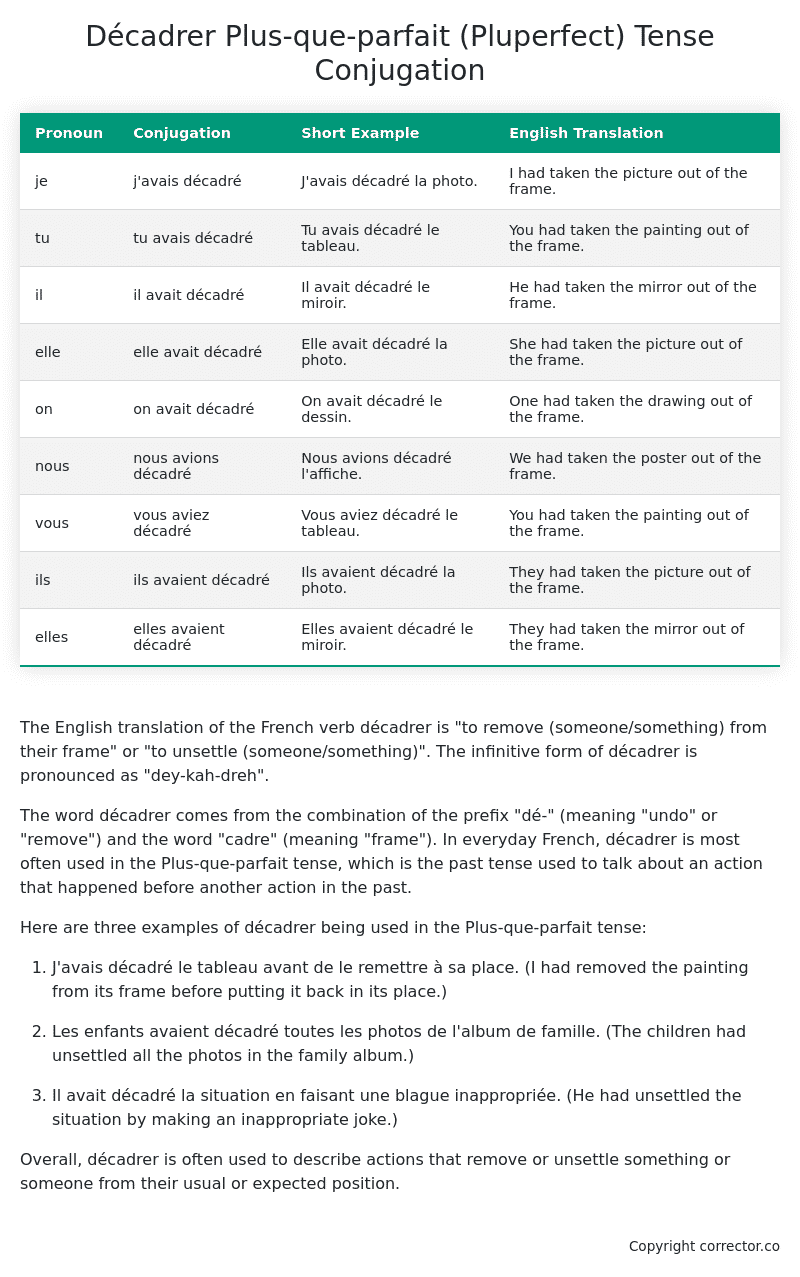Plus-que-parfait (Pluperfect) Tense Conjugation of the French Verb décadrer
Introduction to the verb décadrer
The English translation of the French verb décadrer is “to remove (someone/something) from their frame” or “to unsettle (someone/something)”. The infinitive form of décadrer is pronounced as “dey-kah-dreh”.
The word décadrer comes from the combination of the prefix “dé-” (meaning “undo” or “remove”) and the word “cadre” (meaning “frame”). In everyday French, décadrer is most often used in the Plus-que-parfait tense, which is the past tense used to talk about an action that happened before another action in the past.
Here are three examples of décadrer being used in the Plus-que-parfait tense:
-
J’avais décadré le tableau avant de le remettre à sa place. (I had removed the painting from its frame before putting it back in its place.)
-
Les enfants avaient décadré toutes les photos de l’album de famille. (The children had unsettled all the photos in the family album.)
-
Il avait décadré la situation en faisant une blague inappropriée. (He had unsettled the situation by making an inappropriate joke.)
Overall, décadrer is often used to describe actions that remove or unsettle something or someone from their usual or expected position.
Table of the Plus-que-parfait (Pluperfect) Tense Conjugation of décadrer
| Pronoun | Conjugation | Short Example | English Translation |
|---|---|---|---|
| je | j’avais décadré | J’avais décadré la photo. | I had taken the picture out of the frame. |
| tu | tu avais décadré | Tu avais décadré le tableau. | You had taken the painting out of the frame. |
| il | il avait décadré | Il avait décadré le miroir. | He had taken the mirror out of the frame. |
| elle | elle avait décadré | Elle avait décadré la photo. | She had taken the picture out of the frame. |
| on | on avait décadré | On avait décadré le dessin. | One had taken the drawing out of the frame. |
| nous | nous avions décadré | Nous avions décadré l’affiche. | We had taken the poster out of the frame. |
| vous | vous aviez décadré | Vous aviez décadré le tableau. | You had taken the painting out of the frame. |
| ils | ils avaient décadré | Ils avaient décadré la photo. | They had taken the picture out of the frame. |
| elles | elles avaient décadré | Elles avaient décadré le miroir. | They had taken the mirror out of the frame. |
Other Conjugations for Décadrer.
Le Present (Present Tense) Conjugation of the French Verb décadrer
Imparfait (Imperfect) Tense Conjugation of the French Verb décadrer
Passé Simple (Simple Past) Tense Conjugation of the French Verb décadrer
Passé Composé (Present Perfect) Tense Conjugation of the French Verb décadrer
Futur Simple (Simple Future) Tense Conjugation of the French Verb décadrer
Futur Proche (Near Future) Tense Conjugation of the French Verb décadrer
Plus-que-parfait (Pluperfect) Tense Conjugation of the French Verb décadrer (this article)
Passé Antérieur (Past Anterior) Tense Conjugation of the French Verb décadrer
Futur Antérieur (Future Anterior) Tense Conjugation of the French Verb décadrer
Subjonctif Présent (Subjunctive Present) Tense Conjugation of the French Verb décadrer
Subjonctif Passé (Subjunctive Past) Tense Conjugation of the French Verb décadrer
Subjonctif Imparfait (Subjunctive Imperfect) Tense Conjugation of the French Verb décadrer
Subjonctif Plus-que-parfait (Subjunctive Pluperfect) Tense Conjugation of the French Verb décadrer
Conditionnel Présent (Conditional Present) Tense Conjugation of the French Verb décadrer
Conditionnel Passé (Conditional Past) Tense Conjugation of the French Verb décadrer
L’impératif Présent (Imperative Present) Tense Conjugation of the French Verb décadrer
L’infinitif Présent (Infinitive Present) Tense Conjugation of the French Verb décadrer
Struggling with French verbs or the language in general? Why not use our free French Grammar Checker – no registration required!
Get a FREE Download Study Sheet of this Conjugation 🔥
Simply right click the image below, click “save image” and get your free reference for the décadrer Plus-que-parfait tense conjugation!

Décadrer – About the French Plus-que-parfait (Pluperfect) Tense
Tense Formation
Common everyday usage patterns
Sequencing of past events
Background information
Hypothetical or reported speech
Interactions with other tenses
Summary
I hope you enjoyed this article on the verb décadrer. Still in a learning mood? Check out another TOTALLY random French verb conjugation!


